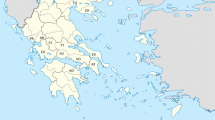Summary
Theileria infection of Hyalomma ticks collected from three districts of Haryana was assessed in whole salivary glands by the methyl-green pyronin staining method. Of 1,662 ticks screened, 546 (32·8%) were found Theileria positive. Infection rate in 935 female ticks (36·9%) was more than that of 727 male ticks (27·6%). Density of Theileria infection (number of infected acini per infected tick) was also higher in female ticks.Theileria infection rate of ticks varied greatly in the three districts viz. only 12·0% in Rohtak, 25·8% in Hisar and 48·3% in Karnal. Per cent infection rate was high (63·7%) in ticks from indigenous cattle and low (18·6%) in those collected from buffaloes. However, the intensity of infection in infected ticks from cross-bred cattle was comparatively much higher. Frequency distribution ofTheileria positive acini in infected ticks revealed a low density of infection per infected tick. This points to the largely stable endemic situation prevailing in Haryana. Only a single salivary acinus was found infected in 16·6% of the infected ticks, about 70% had up to 10 infected acini while only about 10% had over 25 infected acini per tick. The masses in acini presumed to beTheileria were confirmed by demonstrating parasitic masses on staining one of a pair of salivary glands and inoculating the suspension of the other half of the gland into two cross-bred cow calves which developed clinical signs and lesions typical of theileriosis.
Résumé
L’infection theilerienne desHyalomma récoltées dans 3 districts de l’Haryana a été examinée sur les glandes salivaires totales par la méthode de coloration au vert de méthyle-pyronine. Sur 1662 tiques, 546 (soit 32,8 p. 100) ont été trouvées positives pour lesTheileria. Le taux d’infection (36,9 p. 100) de 935 tiques femelles est supérieur à celui de 727 mâles (27,6 p. 100). La densité de l’infection parTheileria (nombre d’acini infectés par tique infectée) est plus grande chez les tiques femelles. Le taux d’infection des tiques varie considérablement selon le district: 12,0 p. 100 dans le Rohtak, 25,8 p. 100 dans l’Hisar et 48,3 p. 100 dans le Karnal. Il est élevé (63,7 p. 100) chez les tiques collectées sur du bétail indigène et bas sur celles prélevées sur des buffles (18,6 p. 100). Cependant, l’intensité de l’infection des tiques prélevées sur du bétail métis est comparativement plus grand. La fréquence de distribution des acini positifs pour lesTheileria chez les tiques infectées révèle une faible intensité d’infection par tique. Ceci montre la situation endémique stable existant dans l’Haryana. On n’a trouvé qu’un seul acinus infecté chez 16,6 p. 100 des tiques infectées; environ 70 p. 100 ont jusqu’à 10 acini infectés tandis que 10 p. 100 ont plus de 25 acini infectés. Les masses présentes dans les acini et présumées être desTheileria ont été confirmées être ces agents par coloration de l’une des paires de glandes salivaires et inoculation de l’autre à deux veaux métis qui ont developpé des signes cliniques et des lésions typiques de theileriose.
Resumen
Se determinó la infectividad theilérica de garraptasHyaloma colectadas en tres distritos de Haryana, examinando las glándulas salivares mediante el método de coloración de la pironina verde-metilo. De 1662 ácaros examinados, 546 (32·8%) se encontraron positivas a theileria. La frecuencia de infección en 935 hembras (36·9%) fue más alta que la encontrada en 727 machos (27·6%). El número de acinos infectados por garrapata infectada fue tambien superior en garrapatas hembras. La fracuencia de la infección theilérica vario en tres distritos. Se encontro el 12·0% en Rohtak, 25·8% en Hisar y 48·3% en Karnal. La frequencia de infección por ciento fue alta (63·7%) en garrapatas de ganado criollo y bajo (18·6%) en aquellas colectadas de búfalos. Sin embargo, la frecuencia de infección en garrapatas de ganado cruzado, fue comparativamente más alta. La frecuencia de distribución de acinos positivos a theileria en garrapatas infectadas, reveló una baja densidad de infección por garrapata infectada. Esto señala una situación endémica estable prevalente en Haryana. Solamente un acino salivar se encontro infectado en el 16·6% de gappapatas infectadas, cerca del 70·0% tuvo arriba de 10 acinos infectados, mientras que solamente et 10·0% tuvo sobre los 25 acinos infectados, por garrapata. Las masas de acinos presumiblemente de theileria, se confirmaron mediante la tinción de la glándula salivar e inoculando parte de ella en terneros cruzados, los cuales desarrollaron theileriosis.
Similar content being viewed by others
References
Bhattacharyulu, Y., Chaudhri, R. P. &Gill, B. S. (1975).Parasitology,71, 1–7.
Gautam, O. P., Sharma, R. D. &Kalra, D. S. (1970).Indian Veterinary Journal,47, 78–83.
Gill, B. S., Bhattacharyulu, Y. &Kaur, D. (1977),Annales de la Société Belge de Medicine Tropicale,57, 557–567.
Irvin, A. D., Boarer, C. D. H., Dobbelaere, D. A. E., Mahan, S. M., Masake, R. &Ocama, J. G. R. (1981)Parasitology,82, 137–147.
Leitch, B. L. &Young, A. S. (1981).Advances in the Control of Theileriosis. (Eds. A. D. Irvin, M. P. Cunningham, and A. S. Young). Martinus Nijhoff, The Hague, pp. 63–65.
Pipano, E., Samish, M. &Krigel, Y. (1982)Veterinary Parasitology,10, 21–27.
Till, W. M. (1961).Memoirs Entomological Society of South Africa,6, 1–124.
Uilenberg, G. (1976).World Animal Review,17, 8–15.
Uilenberg, G. (1982). Proceedings XII World Congress on Diseases of Cattle, Amsterdam, The Netherlands. World Association for Buiatrics, pp. 1025–1032.
Walker, A. R., Young, A. S. &Leitch B. L. (1981)Zeitschrift für Parasitenkunde,65, 63–69.
Walker, A. R., Latif, A. A., Morzaria, S. P. &Jongejan, F. (1983).Research in Veterinary Science,35, 87–90.
Young, A. S. (1981).Advances in the Control of Theileriosis. (Eds. A. D. Irvin, M. P. Cunningham, and A. S. Young). Martinus Nijhoff, The Hague, pp. 38–55.
Author information
Authors and Affiliations
Rights and permissions
About this article
Cite this article
Sangwan, A.K., Chhabra, M.B. & Samantaray, S. Theileria infectivity ofHyalomma ticks in Haryana, India. Trop Anim Health Prod 18, 149–154 (1986). https://doi.org/10.1007/BF02359525
Accepted:
Issue Date:
DOI: https://doi.org/10.1007/BF02359525




